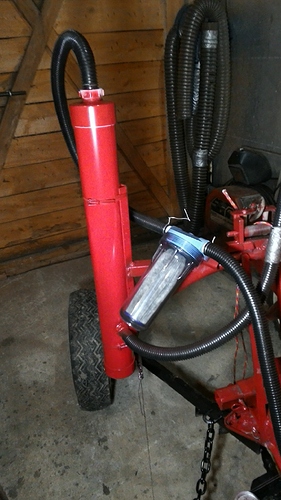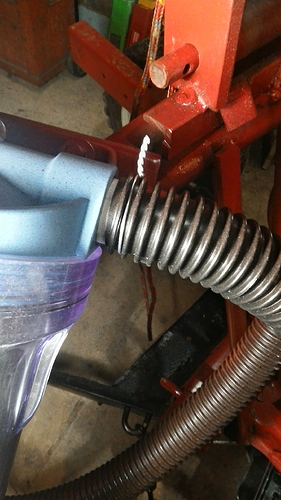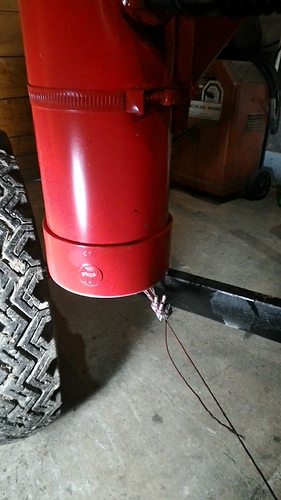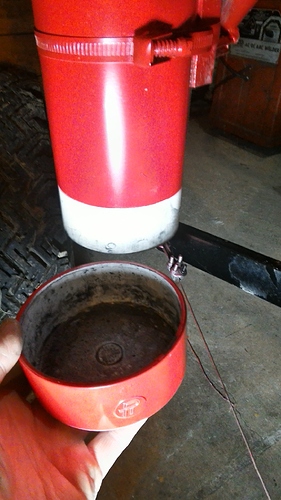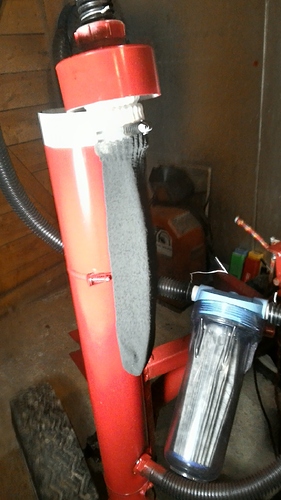I am going to play with this 55 gallon gasifier some more before handing it over to its new owner , i shall trial a few ways to improve start up on the old charcoal by first trying a 3 or 4 inch auger shaft down into the middle of the drum and see if bringing up the older charcoal and replacing it with the fresh charcoal i topped the drum up with from above will make much of a difference .
Dave
OK. Dissolved gases. I heat tea water in a clear tea pot every morning so I will take a closer look at those early bubbles.
Yes, interesting that we never mentioned the restart issue before. I wonder if there are other common experiences that we have failed to bring to the surface for discussion?
Since we have gone a little off the topic of filters, I also wonder if this discussion deserves its own topic called Starting and Restarting Charcoal Gasifiers.
Hi Bruce, it sounds like the charcoal left in the gasifier is a filter of sorts. Cleaning the old charcoal out with all of its contaminate of ash, clunkers, H2O, and basic structure change to the carbon all being held around the nozzle area and though out the feed stock before a start up, sounds like cleaning to me. I would call it stage one of the filtering of the gas before it goes to the second filtering stage of the down stream filter medium used in a canister of sorts. Some people even use charcoal for filtering and moisture collecting.
Stage one is the simplest of the filtering that is going on in the charcoal gasifier system.
If your simple medium filter was all plug up it would be hard to start the gasifier because of no air flow. Plugged up charcoal around the nozzle with ash is no difference.
Changing the feed stock out before every start up will help keep the secondary medium filter clean, and it will last longer before changing out, with some new filtering medium.
There are a lot of good points for starting with fresh charcoal on start ups that I have never though about before.
And yes this is a great thread discussion, I’m learning a lot here from all the DOW members input. Thanks
Bob
Over view.
as many slip fits as possible. Use fence wire to snug up for. No fancy tool, just pliers.
bottom slips right off. Always stays on. All PVC is thin wall stuff.
looks like I glues one of those threaded fittings but the top just slides off. Cotton sock is a poor choice because it stretches and opens the weave. But I never try to clean it much, just a small shake or tap. A year and a half ago I bought a towel to make a new sock but a year ago I used the towel as a towel now I should buy another towel at the Dollar Store.
Is the inlet to your sock/towel filter at the bottom? If so, doesn’t the vacuum at the top tend to suck the sock closed and flat?..Would a fine wire cage on the inside to hold the shape make it more efficient? TomC
Tom, the inlet is at the bottom The out let is on the top And yes the sock has a cage inside. I do not remember if this one is a wire cage or a PVC pipe with big holes drilled in it. I think I liked the fence wire cage better but so much time goes by I forget.
Edit: I mixed up my inlet and outlet.
Jeff,
Is the small clear filter for catching big dust? Instead of cyclone? Interesting. A simple visible coarse filter followed by a fine sock filter. My wife sewed some filter socks for me from an old wool blanket.
I have used that kind of clear filter as a final/safety filter and wrap the screen with white fiberglass cloth to visually judge effectiveness of main filter.
How about 40 mesh screen followed by wool sock, followed by 40 micron safety screen?
Hi Bruce. The final filter is the clear water filter, 30 micron. The course filter is the sock that is inside the the long red thin wall PVC pipe. Seems to work pretty much as is.
OK, got it.
I was confused because you said that the inlet is on top and the picture shows the clear filter in the hose before going to the top inlet.
How many hours do you have on the 30 micron filter?
I never kept track. I just run the stuff now a days. Don’t have to think about, just light the fire and kick the tires!
Bruce, I’m the one confused. I woke up this morning and it hit me that I had the inlet and outlet mixed up. Oops.
I am not able to answer this question. Koen and Aleksandr probably have explanations on this subject.
I suppose narrow reactors (like those of Koen and Aleksandr) realize a more complete reduction of CO2 and water, it generates a richer gas
Thierry
Is there any other reason for a narrow vessel to perform better other than that a greater portion of the the fuel will be freshly added?
[/quote]
I am not able to answer this question. Koen and Aleksandr probably have explanations on this subject.
I suppose narrow reactors (like those of Koen and Aleksandr) realize a more complete reduction of CO2 and water, it generates a richer gas
Thierry
Hi Thierry,
There is indeed “some” influence between the diameter and length vs the amount of power to be generated.
size and position of the nozzle included.
The biggest role however, in making good charcoal gas, besides good fuel, is the filter setup ( the topic )
The less “drag” your “filter” creates, the more easy the system can “breathe” the more gas can be conveyed to your engine.
I will try to extract some data to compare from my research material and post it here.
i will be running with 3 tiny cyclones (in parallel), like a Dyson vacuum cleaner, and fine-grade perlite as a final media filter. I like perlite because it has a massive surface area, won’t burn, can get wet, is washable, and you can burn off the particulates and reuse the stuff almost indefinitely… it’s also cheap…
Anyone else using perlite? I love it…
If the cyclones are operating at 90%, it should be a pretty good system.
What do you think about a filter lid for a wide bodied reactor/hopper that has a layer of coarse perlite followed by fine perlite? A coarse screen to support the coarse perlite and a fine screen above and below the fine perlite. No cyclones or filter plumbing, just one tall column with a clean gas outlet at the top.
For a plug style filter wall action can be an issue. For example a five gallon bucket filled with some kind of media. Inlet at one end and outlet at other. Gas is like electric it takes the path of least resistance. So, the gas will tend to fallow the walls of the bucket and somewhat skip the filter media. Not completely but some.
I can’t help to think that that a charcoal filter would work well. Why wouldn’t it work? I envision a vertical pvc pipe or 2-3 in parallel sharing a condensate tank.One could attach a tee at the bottom so one can use couplers. A flush style screw cap on top so it could be easily emptied.
Jeff,
Thanks for the wall action reminder. What if we glue wool blanket, window screen or foam rubber or something else to the walls? Are there other simple solutions for this phenomenon?
Bruce, I think that would do the trick. Anything to break up the path along the wall. I remember reading something about that. The dirty filter media should tell the story.
